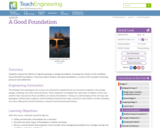
Learn how to use this amazing site https://resourcebank.ca/courses/geoexplore-saskatchewan
- Subject:
- Earth Science
- Environmental Science
- Geography
- Science
- Social Studies
- Material Type:
- Primary Source
- Date Added:
- 06/09/2020

Learn how to use this amazing site https://resourcebank.ca/courses/geoexplore-saskatchewan

Students take part in a hypothetical scenario that challenges them to inform customers at a local restaurant of how their use and disposal of plastics relates/contributes to the Great Pacific garbage patch (GPGP). What students ultimately do is research information on the plastics pollution in the oceans and present that information as a short, eye-catching newsletter suitable to hand out to restaurant customers. This activity focuses on teaching students to conduct their own research on a science-technology related topic and present it in a compelling manner that includes citing source information without plagiarism. By doing this, students gain experience and skills with general online searching as well as word processing and written and visual communication.

Students learn how the greenhouse effect is related to global warming and how global warming impacts our planet, including global climate change. Extreme weather events, rising sea levels, and how we react to these changes are the main points of focus of this lesson.

Students explore the effects of regional geology on bridge foundation, including the variety of soil conditions found beneath foundations. They learn about shallow and deep foundations, as well as the concepts of bearing pressure and settlement.

Students build and observe a simple aneroid barometer to learn about changes in barometric pressure and weather forecasting.

This lesson introduces students to the concepts of air pollution and technologies that have been developed by engineers to reduce air pollution. Students develop an understanding of visible air pollutants with an incomplete combustion demonstration, a "smog in a jar" demonstration, construction of simple particulate matter collectors and by exploring engineering roles related to air pollution. Next, students develop awareness and understanding of the daily air quality and trends in air quality using the Air Quality Index (AQI) listed in the newspaper. Finally, students build and observe a variety of simple models in order to develop an understanding of how engineers use these technologies to clean up and prevent air pollution.

Students learn about energy and nutrient flow in various biosphere climates and environments. They learn about herbivores, carnivores, omnivores, food chains and food webs, seeing the interdependence between producers, consumers and decomposers. Students are introduced to the roles of the hydrologic (water), carbon, and nitrogen cycles in sustaining the worlds' ecosystems so living organisms survive. This lesson is part of a series of six lessons in which students use their growing understanding of various environments and the engineering design process, to design and create their own model biodome ecosystems.

Please find a number of units to support high school science from grades 10 in Saskatchewan.

This comprehensive resource from Saskatchewan Rivers Public School Division includes units of study plus curricular and assessment resources for Grade 11 Arts Education, ELA, Physical Education and Wellness, Practical and Applied Arts, Mathematics, Sciences and Social Studies. Look for rubrics, unit plans, sample year plans (and templates), Treaty Education outcomes and indicators as well lots of other teacher resources. Some of the information is not available as a login is required.

Lying directly south of New Orleans on Louisianas coast, Grand Isle often bears the brunt of strong waves and storm surge in the Gulf of Mexico. To protect this town and inland parishes from flooding, engineers constructed a first line of defense.

In a multi-week experiment, student groups gather data from the photobioreactors that they build to investigate growth conditions that make algae thrive best. Using plastic soda bottles, pond water and fish tank aerators, they vary the amount of carbon dioxide (or nutrients or sunlight, as an extension) available to the microalgae. They compare growth in aerated vs. non-aerated conditions. They measure growth by comparing the color of their algae cultures in the bottles to a color indicator scale. Then they graph and analyze the collected data to see which had the fastest growth. Students learn how plants biorecycle carbon dioxide into organic carbon (part of the carbon cycle) and how engineers apply their understanding of this process to maximize biofuel production.

Learn more about the Great Canadian Shoreline Cleanup, including information on the sources and impacts of shoreline litter and what our national network of volunteers are doing to make a positive difference! Explore interactive maps that contain data from cleanups across Canada in 2017 and discover the most common items found on shorelines. We also provide ideas for how you can get involved by reducing your use and leading a shoreline cleanup in your community!

In this activity, students will use cookies to simulate the distribution of our nonrenewable resources (energy). Then, they will discuss how the world's growing population affects the fairness and effectiveness of this distribution of these resources and how engineers work to develop technologies to support the population.

The Great Pacific Garbage Patch (GPGP) is an intriguing and publicized environmental problem. This swirling soup of trash up to 10 meters deep and just below the water surface is composed mainly of non-degradable plastics. These plastic materials trap aquatic life and poison them by physical blockage or as carriers of toxic pollutants. The problem relates to materials science and the advent of plastics in modern life, an example of the unintended consequences of technology. Through exploring this complex issue, students gain insight into aspects of chemistry, oceanography, fluids, environmental science, life science and even international policy. As part of the GIS unit, the topic is a source of content for students to create interesting maps communicating something that they will likely begin to care about as they learn more.

Students form expert engineering teams working for the (fictional) alternative energy consulting firm, Greenewables, Inc. Each team specializes in a form of renewable energy used to generate electrical power: passive solar, solar photovoltaic, wind power, low-impact hydropower, biomass, geothermal and (for more advanced students) hydrogen fuel cells. Teams produce poster presentations making a case for their technology and produce an accompanying PDF document using Adobe Acrobat that summarizes the presentation. This activity is geared towards fifth-grade and older students, and Internet research capabilities are required. Some portions of this activity may be appropriate with younger students.

How do greenhouse gases affect the climate? Explore the atmosphere during the ice age and today. What happens when you add clouds? Change the greenhouse gas concentration and see how the temperature changes. Then compare to the effect of glass panes. Zoom in and see how light interacts with molecules. Do all atmospheric gases contribute to the greenhouse effect?

Faced with the potential of a large expense related to water quality, the Portland (Maine) Water District performed a thorough analysis of their options. Their choice came down to making an investment in conservation or concrete.

The class forms a "Presidential Task Force" for a week, empowered by the president to find answers and make recommendations concerning the future of the national power grid. Task force members conduct daily debriefings with their research team and prepare a report and presentation of their findings for the president, using an actual policy document as a guide. Although this activity is geared towards fifth-grade and older students and Internet research capabilities are required, some portions may be appropriate for younger students.

Student teams locate a contaminant spill in a hypothetical site by measuring the pH of soil samples. Then they predict the direction of groundwater flow using mathematical modeling. They also use the engineering design process to come up with alternative treatments for the contaminated water.

Students discover how tiny microscopic plants can remove nutrients from polluted water. They also learn how to engineer a system to remove pollutants faster and faster by changing the environment for the algae.